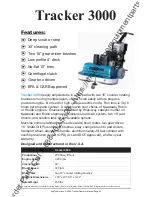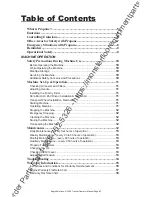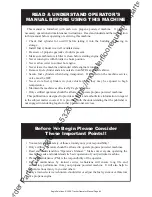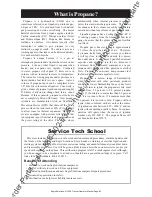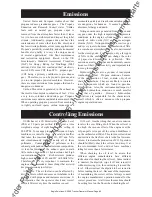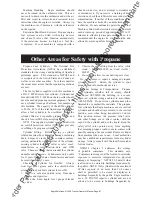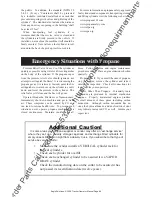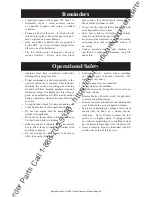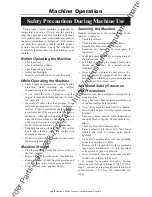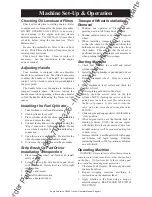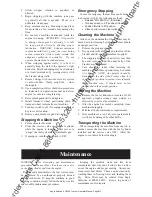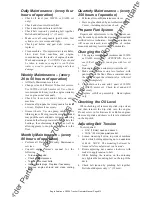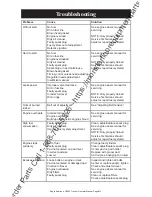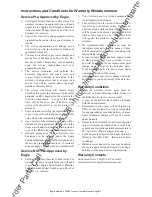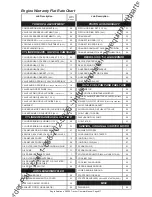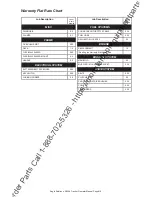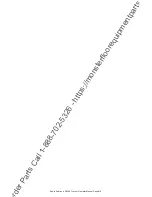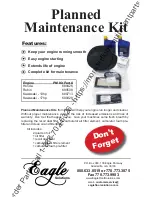
Eagle Solutions, ©2008, Tracker Operator Manual Page #6
Eagle Solutions, ©2008, Tracker Operator Manual Page #7
Machine Handling: Eagle machines should
never be turned on the carburetor side. This can
cause oil to drain into the carburetor and/or the air
filter and result in oil smoke and increased toxic
emissions when the engine is restarted. Always tip
the machine over, if necessary, with the carburetor
on the topside.
Emissions Shut Down Systems: Propane engine
fuel systems can be fitted with safety devices
and shut-off valves that function automatically
if the emissions become too high or a fuel line
is ruptured. If your machine is equipped with a
shut down device, do not attempt to circumvent
or disconnect it. If you receive a warning of high
emissions, check the air filters for excess dust or oil
contamination. If neither of these conditions exist,
have the machine checked by an authorized service
technician. Do not continue to operate the machine!
Machines fitted with electronic emissions controls
need a warm-up period of approximately 12 to 15
minutes to effectively dissapate emissions, so it is
recommended the engine be started outside and
allowed to warm up before bringing it inside.
Other Areas for Safety with Propane
Propane Fuel Cylinders: The National Fire
Protection Association (NFPA) has established
standards for the storage and handling of liquefied
petroleum gases. This standard is NFPA58 and
is recognized in the United States and Canada as
well as some other countries. For other countries
the owner must assure that the required regulations
are met.
The fuel cylinder supplied with this machine is
a D.O.T. 4E240 motor fuel cylinder. Cylinders not
branded with D.O.T. 4E240 on the top collar should
never be used on propane powered equipment. Never
use a cylinder from a gas barbecue, for example, on
this machine. The capacity of the 4E240 cylinder
is 20 lbs., 80% of the total liquid capacity. Never
allow a fuel cylinder to be overfilled. Have the
cylinder filled at a reputable propane dealer and
check it for overfill before accepting it.
OPD: The supplied cylinder is also fitted with
an overfill protection device (OPD) that prevents
overfilling of a propane cylinder.
Cylinder Filling: Before having a cylinder
refilled examine the cylinder for damage, including
dents, bulges or cracks on the container surface,
rusting, particularly on the bottom of the cylinder,
missing cylinder foot ring, collar or valve cover,
manufacture or recertification date, and OPD
valve. These are things that can render the cylinder
unusable and dangerous. Cylinders are only usable
for 12 years from the date of manufacture and must
be recertified every 5 years.
Checking a Cylinder for Overfill: Always
wear frost proof gloves and a face shield before
attempting to check fuel cylinder for overfill.
1. Take to a safe area outside, away from open
flames and cigarettes.
2. Open the fixed liquid level gauge (bleeder
valve).
3. Observe the gas exiting from the valve: white
cloud = OVERFILLED; no cloud visible =
SAFE!
4. If overfilled, allow to vent until vapor is clear.
Do not attempt to repair a damaged propane
cylinder yourself. Return the cylinder to your
propane vendor for authorized service.
Cylinder Storage & Transportation: Propane
fuel cylinders, whether full or empty, should
be stored OUTSIDE the building in a secure,
approved cylinder storage cabinet in accordance
with NFPA58. Do not store cylinders near other
flammable or combustible materials. The propane
fuel cylinders that Eagle machines use are vertical
cylinders and should always remain in the vertical
position, even when being transported or stored.
This position assures the pressure relief valve
and other fittings are in direct contact with the
vapor in the cylinder and not the liquid. Keep the
safety relief valve pointed away from anything
that escaping propane could come in contact with
possibly causing a fire or accident. Remove cylinder
from machine when not in use. Local authorities
may have additional requirements for fuel cylinder
storage. Always consult with the local fire marshal
for local codes.
NFPA58 Chapter 5 addresses the storage
of portable containers. This standard says,
“Containers in storage shall be located to minimize
exposure to excessive temperature rise, physical
damage, or tampering.” NFPA58 5-3 details what
is allowed to be stored in buildings frequented by
the public. NOTE: Only cylinders with a maximum
LP-Gas capacity of no more than 16.8 ounces
shall be permitted to be stored or displayed in
buildings frequently by the public. Eagle machines
use a 20 POUND capacity cylinder and are not
allowed to be stored in buildings frequented by
To Order Parts Call 1-888-702-5326 - https://monsterfloorequipmentparts.com


